- You are here:
- Home »
- Mike Smith
Tag Archives for " Mike Smith "

Practice Communication
By Mike Smith –
I say it all the time, hear it said all the time and even study it quite a bit- yet few of us actually practice it – communication. While good communication is a foundation of success on the field at every level and position, for me it all starts with the keeper. For whatever reason, a vocal forward , midfielder or defender doesn’t always equate to a vocal team but almost always, a vocal keeper creates a domino effect and will improve the communication of all the players on your squad. Perhaps it is because the keeper can easily see and communicate with every one? Regardless of the “whys” practicing communication with your keeper will pay dividends both for them and your entire group.
Set Up
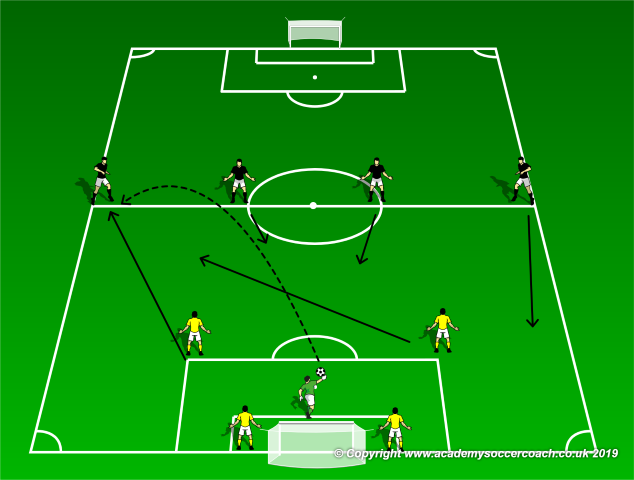
Play starts with the keeper making a distribution out to 4 attackers ( shown above ) spread across the half line ( a cone line can be placed across the top of the defensive third as a starting mark for younger groups ). The keeper always makes the distribution wide to start. Two defenders step to provide pressure and cover, as shown below.
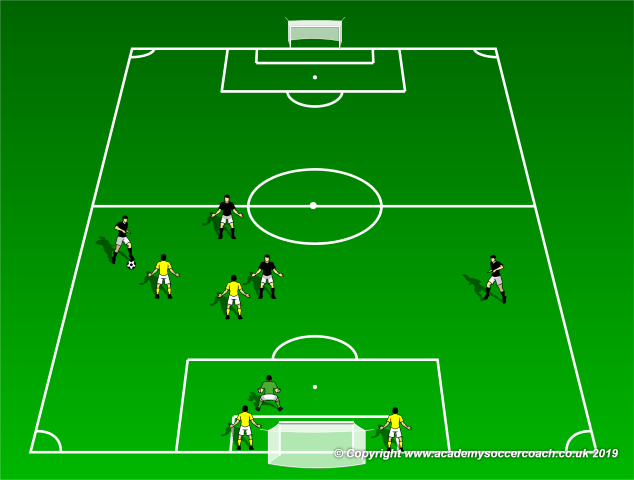
It is now the keeper’s responsibility to tell the two remaining defenders ( waiting on the post ) where to go. Does one double the ball and the other provide balance in the center? Does one provide balance in the center and the other one pick up the wide attacker? This is all up to the coach and keeper but regardless of the plan or style of play, the keeper must instruct the defenders. The coach can set a time for the attacking groups of 4 to possess or create a shot ( 10 seconds per group for example) and groups of defenders and attackers may rotate in and out. Any defensive win or clear restarts play with a new group.
Progression
As shown below, the drill can progress to 6 v 7 by allowing 2 attackers to start as forwards with their backs to goal marked by a line of 4 defenders. An additional defender is placed on the half line with the two final defenders waiting on the posts for the distribution to be made. The idea here is for the keeper to instruct the defender on the half line to either drop in, cover wide, or pressure the ball. Once the wide attacker has the ball, the defenders on the posts may enter play with or without specific instructions from the goalie.
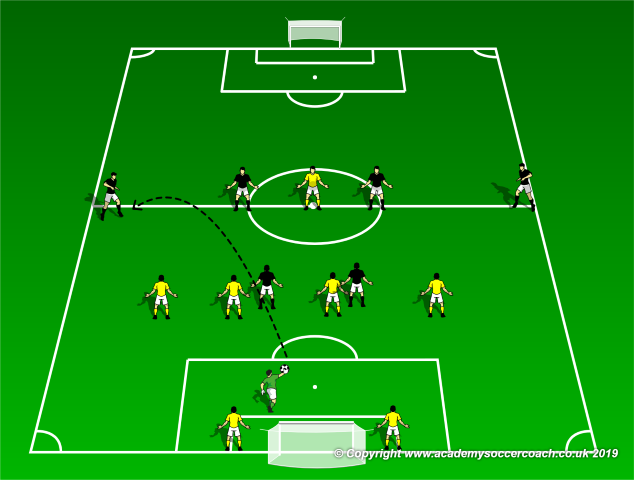
Additional defenders and attackers can be added to make this a half field scrimmage as a final progression, scoring rules for the defense ( possession, clearance out, advancing over the half line ) are up to the coach.
Coaching Points
The coach should work with the keeper on being vocal with the defenders and the pressuring midfielder. As the drill progresses, all the defensive players should be in constant communication based on the keepers initial instructions.
By Mike Smith
Currently the Head Coach for University Heights Academy Boys Soccer in Hopkinsville, KY , Mike is in his 14th year as a high school head coach with 23 years coaching experience overall and 34 year as a student and fan of the game. He holds a USSF D License.
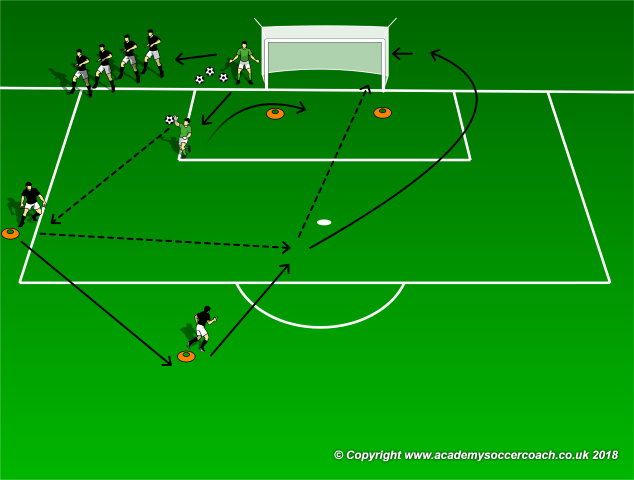
Get Off the Line
By Mike Smith –
Over the course of my 24 years of coaching in general and 16 years of coaching high school, one of the constants I have faced is the need to “make” a keeper. Most coaches have moved around a bit as far as teams and age groups coached, but in all my travels I have only inherited 3 actual keepers. The reason I mention this in an article about getting off the line is that playing keeper is intimidating and already takes a special kind of player. When this player is new or just trying it out to help the team, this intimidation often shows up with the keeper standing on the line. While good line play is a staple of good keeper play, we all know getting stuck there can spell disaster sometimes, so here is what I do the help the keepers “ get off the line”.
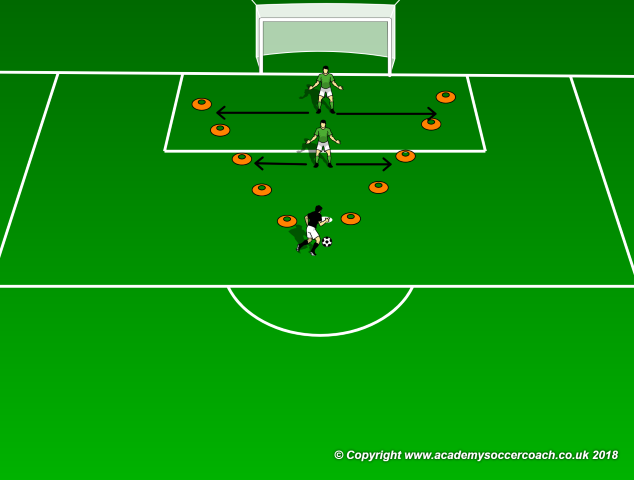
First, I explain to them about what I call the “ shooters V “. I set up cones as shown above and explain that this basic V shape pivots with the shooter and most of the time, the ball is going somewhere in this V ( unless the shooter shanks it, whiffs it or skies the bar – all fine from a keepers stand point ). Once keepers understand if they sit back, they have to cover more ground to make the save ( noted by the upper keeper and movement lines ) than if they step up and cut down the angle ( and coverage distance ) a bit ( noted by the lower keeper and movement lines ) they readily move out more. Obviously too close and they risk being burned by fancy footwork so again, most readily understand the benefits of stepping out a bit.
After a good warm up, we do a bit of shooting, with a twist:
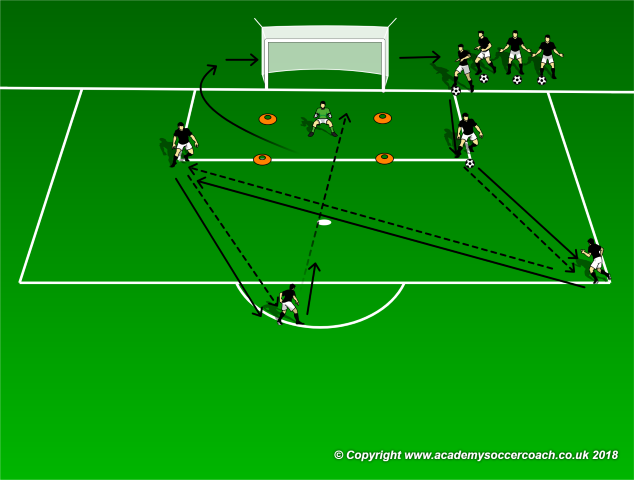
Set Up
As shown above, cut the keeper box in front of the frame in half and have your keeper ( keepers ) make saves from there. Any shooting progression can be used, I use the one shown above most often as it mixes in short passes, diagonal passes, set up passes and shots from around the pk spot ( the shooter shags the ball so there is a bit of running there too). The numbers of shooters should allow for minimal recovery time as this should progress fairly quickly. Multiple keepers can rotate in after a set number of shots ( 5 – 7 ).
Progression
Once the keeper is comfortable operating in the area off the line in front of the goal, remove the top two cones from the keeper box and re-position the shooters as shown below. This drill starts with the keeper distributing the ball from the top of the 6 to an attacker who lays the ball across around the penalty spot. Another attacker rushes in for the shot. The keeper must distribute the ball the sprint behind the cone gate to attempt the save from between the cones. The shots should come in quickly enough to force the save just as the keeper is getting near the cones so attacker starting positions should be adjusted to facilitate this. After a save attempt, the saving keeper either digs the ball out of the net and then drops out, or drops out after a save with the shooting player collecting the ball. The in coming keeper waits until the net is clear to make the next distribution. Shooters rotate as shown.

A final progression would be a half field scrimmage 8 defenders vs 10 attackers to see how the keeper adjusts moving to and from the line.
Coaching Points
During the drills the coach should focus the keeper on cutting down the angles and being ready to make the save. For beginning keepers, just getting a hand on the ball is a win. During the scrimmage, the coach should stay by the goal and give the keeper cues on when to step out and when to hold the line but the overall main idea is to get the keeper comfortable using the right space inside the box at the right time – especially when it is time to “ get off the line”.
By Mike Smith
Currently the Head Coach for University Heights Academy Boys Soccer in Hopkinsville, KY , Mike is in his 14th year as a high school head coach with 23 years coaching experience overall and 34 year as a student and fan of the game. He holds a USSF D License.
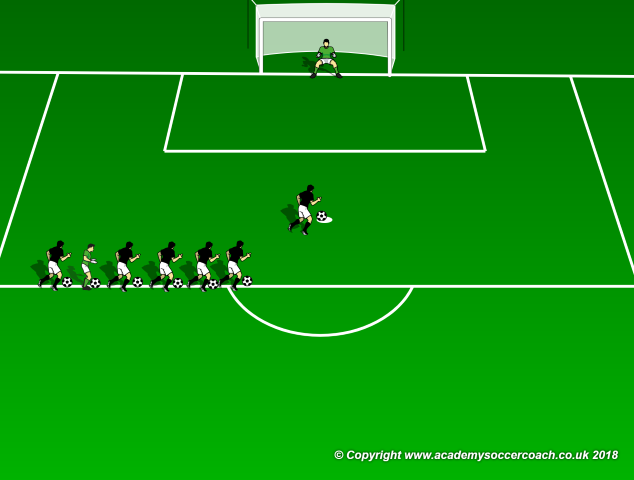
Get Better on PKs
By Mike Smith –
There is no higher pressure situation for a keeper to face than that of a PK. Some could argue a 1 v 1 breakaway where the attacker is coming in at speed is more challenging but I would argue since the keeper is not limited as far as movement during run of play 1 v 1 scenarios, the PK gets the edge. Obviously most coaches know this and thus, most teams and keepers practice PK s regularly, so the issue here is not “ are you practicing pks, “ but “ HOW are you practicing pks”? Here are two specific tricks which will vastly improve your keepers stop percentage AND your teams shooting percentage.
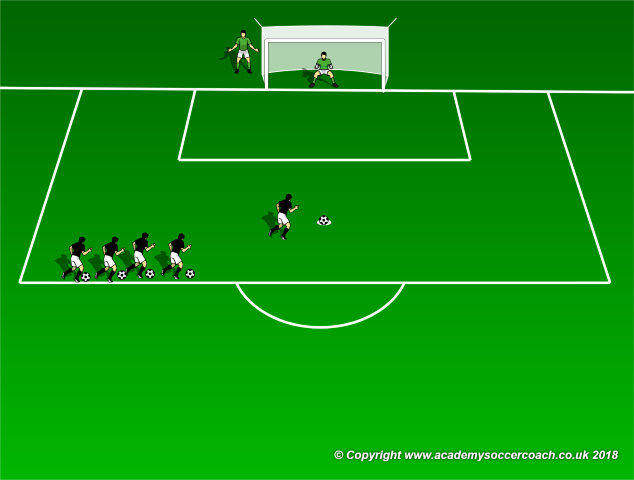
Many pk practices look like this, many of mine included. I usually work with groups of 5 shooters and two keepers as this best simulates a shoot out, with the keepers alternating shots. My remaining players run passing lines and do touch work until each shooting unit has done 3 progressions. Here is trick #1 : My shooters TELL the keeper which way they are going. Here is why: Many times, keepers do not learn how to react the right way because they spend too much timing guessing which way the kick is going. By telling them at practice, especially early in the season ( or pre season ) the keepers get a chance to commit to the proper form going to the left, right, high and low. It also helps with the shooters accuracy and how the shooter deals with pressure.
The second trick helps with moving to the ball with a slight forward angle and the most common pk fault, the keeper leaving the line early. With the same basic practice set up, make the keeper start INSIDE the goal.
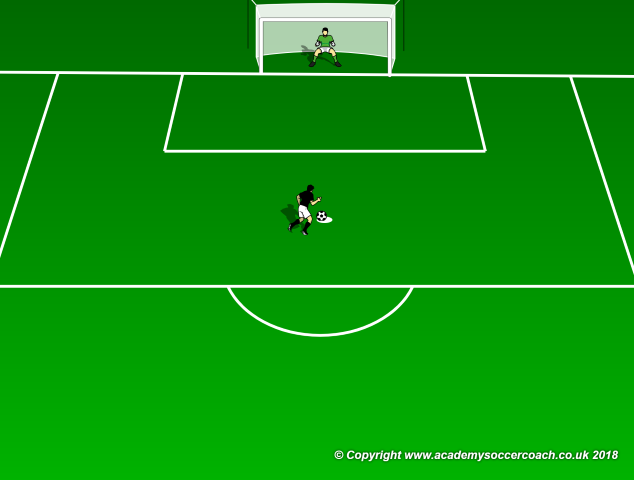
As shown above, by starting the keeper inside the goal, just a couple feet or one step, yet still asking them to keep the ball in front of the line, it forces them to add a slight forward angle to their lunges and parries. This forward angle can be the difference in a ball being pushed out clear or tipped, spun and then going in. It also allows for any second chance attempts to be made before the ball actually crosses the line. The setup is the same as in the previous activity.

To make this a complete session, have each keeper face 7 consecutive pk attempts, from the line WITH OUT being told the direction. Be sure to include the keepers in the rotations of 7.
Coaching Points
The focus is on keeper form here and committing to a direction once they have tried to make a read ( guess )on the shooters intended shot. The coach should encourage the keeper to be as big as possible, use a slight forward move and aggressively parry shots away.
By Mike Smith
Currently the Head Coach for University Heights Academy Boys Soccer in Hopkinsville, KY , Mike is in his 14th year as a high school head coach with 23 years coaching experience overall and 34 year as a student and fan of the game. He holds a USSF D License.
